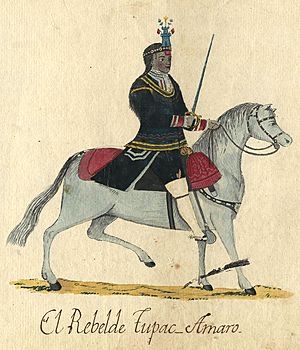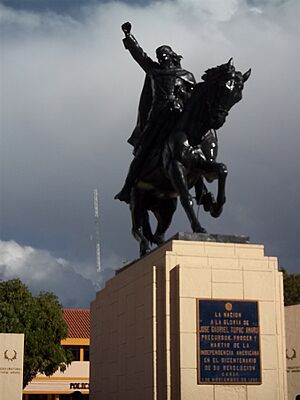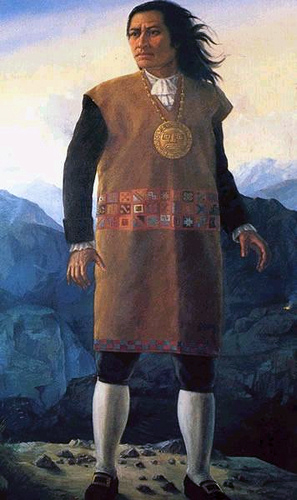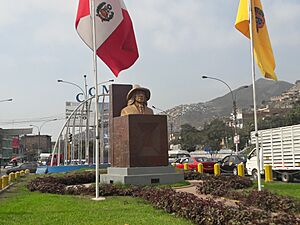Túpac Amaru II facts for kids
Quick facts for kids Tupaq Amaru II |
|
|---|---|

This painting of Tupac Amaru II was made around 1784–1806. It is the oldest known picture of the rebel leader.
|
|
| Sapa Inca of the Inca Empire | |
| Reign | c. 4 November 1780 - 18 May 1781 |
| Predecessor | Atahualpa (as legitimate Sapa Inca of the Inca Empire) Paullu Inca (as puppet Sapa Inca of the Inca Empire) Tupac Amaru I (as Sapa Inca of the Neo-Inca State) Juan Santos Atahualpa (as indirect predecessor) |
| Born | José Gabriel Condorcanqui Noguera c. 1742 Surimana-Canas, Province of Cusco, Viceroyalty of Peru |
| Died | May 18, 1781 (aged 43) Cusco, Viceroyalty of Peru |
José Gabriel Condorcanqui (born around 1742 – died May 18, 1781) was an Indigenous leader. He is better known as Tupaq Amaru II. He led a large rebellion against the Spanish rulers in Peru. He called himself the new Sapa Inca (emperor) of a new Inca Empire. Later, he became a hero in Peru's fight for independence and for indigenous rights. He also inspired many movements across Spanish America and beyond.
Contents
Early Life of Tupaq Amaru II
Tupaq Amaru II was born José Gabriel Condorcanqui Noguera around 1742. His birthplace was Surimana, in the province of Cusco. His father, Miguel Condorcanqui Usquionsa Tupaq Amaru, was a kuraka (chief) of three towns. His mother was María Rosa Noguera.
When he was 12, his parents died. His aunt and uncle then raised him. At 16, he went to the San Francisco de Borja School. This school was for the sons of kurakas. The teachers there taught him about his important family history as a future chief and a descendant of Inca royalty.
When he was 22, Tupaq Amaru II married Micaela Bastidas. Soon after, he became a kuraka like his father. This gave him rights to land. He was a leader of several Quechua communities. He was also a merchant and mule driver, owning 350 mules. His trading helped him connect with many other Indigenous communities. He learned a lot about the economy, which helped him during the rebellion.
He was seen as an important Quechua person from a chief's family. He spoke Quechua and Spanish, and learned Latin. He was well-educated and had connections with important Spanish people in Cuzco. People in Lima saw him as a "well-educated Indian."
Around 1776, Condorcanqui tried to claim the title of Marquis of Oropesa, but he lost the case. In 1760, he married Micaela Bastidas Puyucahua. She was of Afro-Peruvian and Indigenous background. Tupaq Amaru II inherited the leadership of Tungasuca and Pampamarca from his older brother. He governed these areas for the Spanish governor.
By the late 1770s, trade rules changed. This made it harder for merchants in Cuzco. They had to compete with goods from Buenos Aires and Spain. Also, there was too much production, which made prices drop. In 1778 and 1779, very cold weather ruined crops and made travel difficult. Tupaq Amaru II, like others, faced these problems. He had money but also many debts. He saw how much people were struggling, from merchants going broke to communities unable to pay rising tribute (taxes).
Condorcanqui was a kuraka, meaning he had to help the Spanish leaders and the Indigenous people. But he was also affected by new customs taxes. He spoke out against these issues. He also asked for Indigenous people to be freed from forced work in mines. He made these requests to Spanish officials, but they often ignored him.
He took the name Tupaq Amaru II to honor his ancestor, Tupaq Amaru I. Tupaq Amaru I was the last Sapa Inca of the Neo-Inca State. By taking this name, he wanted to show his royal Inca heritage.

Why the Rebellion Started
The Spanish had a system where Indigenous people were forced to work. Even though an older system called encomienda ended in 1720, many people still had to do forced labor. This labor was for public projects. Most Indigenous workers were supervised by a master. They worked on farms, in mines, or in textile factories.
The small wages they earned were heavily taxed. This made Indigenous people owe money to their Spanish masters. The Roman Catholic Church also collected money from them for religious services and gifts. Even those not in forced labor were taxed heavily by Spanish governors, called corregidores. These governors also sold goods at very high prices to free Indigenous people, keeping them in debt.
In the mid-1700s, mining increased. This put more pressure on the mita system, which was forced labor for mines. Working in the Potosi mines was dangerous and hard. Workers and their families often had to move to Potosi. The work became even tougher, even though no new valuable minerals were found. Many future rebellions happened in areas near the mining districts.
Tupaq Amaru II became more interested in the Indigenous cause after reading Royal Commentaries of the Incas. This book told a heroic story of the ancient Incas. The Spanish ruler in Lima had banned the book. He feared it would make people interested in Inca culture again and cause a rebellion.
Tupaq Amaru II felt proud of his Inca heritage. He also disliked the Spanish colonial system. He often asked for better conditions for Indigenous workers. He even used his own money to help people pay taxes. When his requests were ignored, he decided to start a rebellion. He stopped collecting debts and tribute payments. Because of this, the corregidor of Tinta, Antonio de Arriaga, threatened him with death. Condorcanqui then changed his name to Tupaq Amaru II. He said he was a descendant of the last Inca ruler, Tupaq Amaru.
The Rebellion Begins
The Tupaq Amaru rebellion was a movement to bring back Inca traditions. It aimed to improve the rights of Indigenous Peruvians. They were suffering under new Spanish rules called the Bourbon Reforms. These reforms made taxes and labor harder for both Indigenous and Creole (Spanish-born in America) people.
The rebellion started on November 4, 1780. Tupaq Amaru II and his allies captured and killed the corregidor and Governor Antonio de Arriaga. This happened after a dinner party. Tupaq Amaru II claimed he was following orders from the Spanish King. He had Arriaga's slave, Antonio Oblitas, carry out the execution. They tried to hang Arriaga in the town square, but the rope broke. Arriaga tried to run, but he was caught and successfully executed on the second try.
After Arriaga's death, Tupaq Amaru II continued his revolt. He announced that Indigenous people had complained many times about the abuses by Spanish officials. He said these complaints had not been fixed. He stated he was acting to stop these abuses and to keep peace for everyone: Indigenous people, mixed-race people, and even native-born whites and blacks.
Tupaq Amaru II quickly gathered an army of 6,000 Indigenous people. They left their work to join the revolt. As they marched towards Cuzco, they took control of several provinces. The rebels looted Spanish houses and killed the people inside. They wanted to overthrow Spanish rule. For many poor Indigenous people, the rebellion meant a chance for a fair society. They hoped for a return to the Inca communal farming system and an end to forced labor.
Women were also affected by these injustices. Tupaq Amaru II's wife, Micaela Bastidas, led a group of rebels. She was in charge of the uprising in the San Felipe de Tungasuca area. Many say she was braver and a better planner than Tupaq Amaru II. She reportedly told him off for not attacking the Spanish in Cusco when they were weak. Instead of listening, Tupaq Amaru II spent time gathering more people. By the time the rebels attacked Cusco, the Spanish had brought in more soldiers. They were able to stop the uprising. This led to the capture of Tupaq Amaru II, Micaela Bastidas, and others.
Tupaq Amaru II convinced Quechua-speaking people to join him. They fought alongside Aymara-speaking rebels from Puno. However, this alliance did not last long. The Aymara leader, Túpac Katari, then led his army alone. He was captured in October 1781. His partner, Bartola Sisa, took over and led 2,000 soldiers for several months. By early 1782, the Spanish military defeated the rebels in Peru and Bolivia. Many leaders were executed, including 32 women.
On November 18, 1780, Cusco sent over 1,300 Spanish and loyal Native troops. The two sides fought in the town of Sangarará. Tupaq Amaru II and his Native rebels won completely. All 578 Spanish soldiers were killed. The rebels took their weapons and supplies. However, this victory also showed that Tupaq Amaru II could not fully control his followers. They killed people without direct orders. Reports of this violence made it impossible for him to get support from the Criollo (Spanish-born in America) class.
After Sangarará, Tupaq Amaru II faced many defeats. His biggest defeat was failing to capture Cuzco. His army of 40,000 to 60,000 Indigenous followers was stopped by the city's defenses. Cuzco had loyal Native troops and soldiers from Lima. After being pushed back from Cuzco, Amaru and his men traveled through the countryside. They tried to get more Natives to join his cause. But his army was surrounded between Tinta and Sangarara. Two of his officers, Colonel Ventura Landaeta and Captain Francisco Cruz, betrayed him. This led to his capture. When his captors asked him to name his rebel friends, Amaru II famously replied, "There are no accomplices here other than you and I. You as oppressor, I as liberator, deserve to die."
The Death of Tupaq Amaru II
Tupaq Amaru II was sentenced to death. Before he died, he was forced to watch his wife, Micaela Bastidas, his oldest son Hipólito, his uncle Francisco Tupa Amaro, his brother-in-law Antonio Bastidas, and some of his captains die.
His youngest son, Fernando, who was 10 years old, was not executed. But he was forced to watch his whole family die. He was later sent to Africa for life in prison. However, his ship sank, and he ended up in Cádiz, Spain, where he was imprisoned.
Even after Tupaq Amaru II and his family were executed, the rebellion did not stop. His cousin, Diego Cristóbal Tupaq Amaru, continued leading it. The rebellion also spread to other areas like Upper Peru (modern-day Bolivia) and the Jujuy region.
What Happened After
When the revolt continued, the Spanish executed the rest of his family. Only his 12-year-old son Fernando was spared from death. He was imprisoned in Spain for the rest of his life. It is not known if any other members of the Inca royal family survived.
Tupaq Amaru's body parts were sent to towns that supported him. His houses were destroyed, and salt was spread on the land where they stood. His belongings were taken, and his relatives were shamed. All documents about his family history were burned.
Also, on May 18, 1781, Inca clothing and cultural traditions were outlawed. It became illegal to call oneself "Inca." These rules were meant to force the population to adopt Spanish culture. This continued until Peru became an independent country. However, even after Amaru's death, Native revolts continued in southern Peru, Bolivia, and Argentina. Native rebels captured Spanish towns and executed many people. In one case, a Native-American army led by Túpac Katari surrounded the city of La Paz for 109 days.
The Impact of the Rebellion
Tupaq Amaru II's rebellion was not successful in the end. But it was the first large-scale rebellion in the Spanish colonies. It inspired many Natives and Peruvians in the area. The rebellion had a big impact in "Upper Peru," which is now modern Bolivia.
The rebellion gave Indigenous Peruvians a new sense of identity. It created a kind of Indigenous nationalism. This feeling would appear again and change over Peru's future. They were now willing to join anyone who opposed the Spanish. While Tupaq Amaru II's revolt started in the Vilcanota Valley and ended in Cuzco, its ideas spread throughout the Andean region.
Tupaq Amaru II's Legacy
In Peru
- During the Revolutionary Government of the Armed Forces (1968–1980), Tupaq Amaru was chosen as a symbol for their ideas.
- The Tupaq Amaru Revolutionary Movement (MRTA) was a Peruvian group. They became known for their part in the Japanese embassy hostage crisis.
In Music
- The Venezuelan composer Alfredo del Mónaco wrote a symphonic poem called "Tupaq Amaru" in 1977.
- The Peruvian composer Armando Guevara Ochoa wrote a symphony (No. 5) called "Tupaq Amaru."
- The song "Águila de thunder (part II)" by Luis Alberto Spinetta is inspired by Tupaq Amaru II.
- The French hip-hop group Canelason has a song called "Libre" about him.
- The Polish reggae band NDK mentions his death in their song "Mafija."
- The American rapper Tupac Amaru Shakur was named after him.
- The song "This Is Not America" by Residente mentions Tupac Amaru II.
In Books
- In the book Inca Gold by Clive Cussler, a villain calls himself Tupac Amaru.
- The beginning of the book The Book of Human Skin describes Tupaq Amaru II's death.
- The book Tupaq Amaru by Ramón J. Sender explores his thoughts before the rebellion.
Around the World
- The Tupamaros were a group in Uruguay in the 1960s and 1970s. Their name came from Tupaq Amaru II and his ideas.
- The Venezuelan political party Tupamaro is also named after him.
- Operation Tupac was a plan launched by Pakistan.
- The Chilean poet Pablo Neruda wrote a poem about Tupaq Amaru II called "Tupac Amaru (1781)." It is in his book Canto General.
See also
 In Spanish: Túpac Amaru II para niños
In Spanish: Túpac Amaru II para niños
- Túpac Katari
- Mateo Pumacahua



